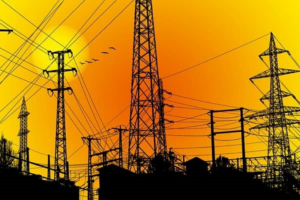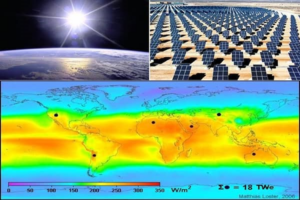5 Types Of Kinetic Energy
There are total v types of kinetic energy as listed below:
- Mechanical free energy
- Electrical energy
- Radiant energy (or Light energy)
- Thermal energy
- Sound energy
Kinetic energy:
On a wide level, Energy is a quality of objects that may be transferred to other objects or transformed into unlike forms, merely it cannot be created or destroyed. In objects, it is a quality that may be transmitted from i particular to another or turned into multiple forms in different situations.
Kinetic energy is defined equally the energy that is associated with items that are in motion or moving. For example, while an aeroplane is in flight, the aeroplane is moving through the air at a high rate, exerting force on its surround and causing alter to occur. The jet engines work by transforming potential energy in the fuel to kinetic energy in the form of movement and thrust.
Our agreement of KE and how we employ information technology in scientific discipline is well-established. Make it more relatable now by talking nearly the 5 distinct types of KE and how we utilise them in our everyday lives, to illustrate our indicate.
Read more on uses of kinetic energy.
Types of kinetic energy
Mechanical energy:
Information technology is the course of energy that can exist seen with our eyes that is known every bit mechanical energy. The greater the speed at which an item travels and the bigger the mass it possesses, the greater the mechanical free energy it possesses and the greater the ability of the thing to perform work. A adept illustration is when a bowling ball hits a pin in a game of bowling. A windmill, on the other hand, can collect current of air energy, and a hydroelectric dam tin can create power from a moving water source, which is more pregnant.
Prototype Credits: Epitome by VIVIANE MONCONDUIT from Pixabay
Electrical energy:
Electric energy is the amount of energy that electrons take when they are travelling. A small group of particles known as atoms brand upwardly all of the items in the universe. Atoms are composed of very minor components such as electrons, protons, and neutrons, which combine to course a molecule.
In an atom, the electrons that are present travel effectually the nucleus of the atom at all times. Atomic electrons gain energy and become free when a voltage or electric field is delivered externally to the atom's nucleus. Electrical energy or electricity is the term we use to draw the energy carried by a costless electron. A desk-bound light or a prison cell phone that is connected into the wall are both powered by the motion of these electrons in our daily lives.

Paradigm Credits: Image by Susan Cipriano from Pixabay
Radiant energy (or Lite energy):
Radiant free energy is the term used to describe the energy involved in electromagnetic radiation or light. Radiant energy is as well referred to as electromagnetic energy in some circles. This energy has the ability to move through infinite or via a medium. As we all know, kinetic free energy is divers equally the energy of motion. Radiant energy is constantly in move as it travels across space or via a medium. This has resulted in information technology existence referred to as a kind of kinetic energy. Radiant free energy is emitted by everything that has a thermal country.
A number of various types of radiation tin be used to stand for radiant energy, including gamma rays, X-rays, ultraviolet light, visible low-cal (violet, indigo, blue, greenish, yellow, orange, and scarlet), infrared radiation, microwaves, and radio waves. Radiant free energy is besides used to draw the energy that the sun sends out into space to accomplish the planet. If the energy is directed in a direct path, it moves at an extremely loftier speed (3 × 10eight chiliad/southward).
Depending on the wavelength of the radiant free energy or light energy, it may be visible to the human being eye or invisible to the naked eye. The joule is the SI unit of measurement of radiant energy, just as it is for all other forms of energy in the universe. The dominicus'south heat is a articulate case of radiant energy. Lightbulbs, a toaster in your kitchen, and X-rays are more examples.
Read more on examples of low-cal energy

Image Credits: Kurt Salzmann, Light Energy, CC BY 3.0
Read more on what is kinetic energy of light.
Thermal energy:
Heating and cooling are both examples of thermal energy, which may be perceived by people in the form of oestrus. Thermal energy, on the other hand, has everything to exercise with the amount of cantlet and molecule activity in a given item. The faster the speed at which they are travelling, the greater the probability that they will collide with 1 some other. In a physical object, thermal energy refers to the internal energy produced by the move and standoff of atoms and molecules. The temperature or a thermal energy of a substance tin exist measured in degrees Celsius. Thermal energy is indeed referred to as estrus energy in some circles.
It is the atoms and molecules that serve as the fundamental building blocks of all stuff in the cosmos. Throughout this system, all of the atoms and molecules are constantly moving. Nosotros can't observe the motion of this energy with our eyes since it is invisible to them. When information technology comes into contact with our skin, we tin can feel it. For example, when standing outside in the sun, you cannot encounter the rut. But you tin can ever feel the heat.
Thermal energy is created when atoms and molecules clash with i another as they motion faster than they tin can go. The kinetic energy of the atoms and molecules in a substance's composition determines the thermal energy of the matter. The atoms in hotter substances will travel or vibrate more than chop-chop, resulting in a greater corporeality of kinetic energy. As a result, they will generate more thermal free energy.
The kinetic energy of the atoms in colder substances, on the other hand, is significantly smaller. Every bit a consequence, they volition produce far less rut. Thermal energy, like all other types of free energy, is measured in Joules besides equally other units of measurement like Celsius. Examples of thermal free energy include the rut generated by your oven and the energy required to power your car'southward engine. Another example includes the word "thermal" in its name: geothermal energy is a renewable resources that nosotros utilize to create electricity for usage in our homes and businesses.

Epitome Credits: Apteva , Solar free energy , CC Past-SA three.0
Sound energy:
Vibration of an item generates audio free energy, which is a sort of energy. By transferring energy between particles, this free energy may travel across any material and can be detected by the man ear when information technology gets close plenty to the ears. If you have a vibrating object in your environment, the free energy from the object is transmitted to the nearby surrounding particles, enabling them to vibrate as well. Post-obit that, the particles smash with some other set of particles, and the wheel continues. Audio energy is transferred from i particle to another in the same mode.
Vacuum does not permit the transmission of sound energy since it does not contain any particles that may serve equally carriers of sound free energy. Information technology can just be transported through some kind of medium such as water, air, or solid. Sound is produced past vibrations, which may be produced by annihilation from the loudest pulsate to the smallest buzzing bee. Alarms, car horns, thunder storms, conversing with others, drumming, crackers, and other forms of sound energy are examples of this blazon of energy.

Epitome Credits: "Condenser Studio Microphone with Sound South " (CC BY 2.0 ) by wuestenigel
So, these all are the important v types of kinetic energy
Ofttimes Asked Questions (FAQ)
Q. When it comes to kinetic energy, what is the definition?
Ans: Basically, in that location are two types of energy. Ane of these is kinetic energy (KE).
It'southward the amount of effort necessary to advance a body of a given mass from rest to a sure velocity.
Q. What is the formula for kinetic free energy or how do we stand for the kinetic energy?
Ans: The equation of kinetic energy is shown as below:

Where,
KE = Kinetic free energy
m= mass of the body
v= velocity of the body
Q. When an object with mass of 100 kg is moving with the velocity of xx one thousand/southward. Then what volition be its kinetic energy?
Ans: We know that the equation of kinetic energy is given equally
KE = ½ mv2
Given, chiliad = 100 kg and five = 20 m/s
Putting these values in above equation of kinetic free energy, we become
KE= ½ (100 kg) × (20 grand/southward)
KE = thousand J or ane KJ
Therefore, the kinetic energy of an moving object is one thousand J or ane KJ.
Q. Depict how the kinetic free energy differs in nature from the potential energy.
Ans: Potential energy refers to the energy that a body has only because of where it is in relation to other objects. Kinetic free energy refers to the energy held by a torso as a issue of its motility.
Q. When it comes to Kinetic Energy, what are its characteristics?
Ans: Kinetic energy is created when a body moves. It permits us to shift speed. Here are some more than kinetic energy characteristics:
- When the object's velocity changes, kinetic energy may ascension or autumn depending on that change.
- Information technology is more prominent in heavier items.
- It has the ability to convert into different forms of energy.
- Any moving item will experience this phenomenon regardless of its management of movement.
- Its units of measurement are joules (J).
Q. What are the dissimilar examples of kinetic energy?
Ans: Following are the unlike examples of the kinetic free energy:
- Moving automobile
- Riding a wheel equally well as bike
- An aeroplane in the sky
- Roller coaster
- Skateboarding
- Rowing
- Industrial machines
- Bullock cart
- Brawl thrown in the air
- Windmills
5 Types Of Kinetic Energy,
Source: https://lambdageeks.com/types-of-kinetic-energy/
Posted by: owenscrind1984.blogspot.com


0 Response to "5 Types Of Kinetic Energy"
Post a Comment